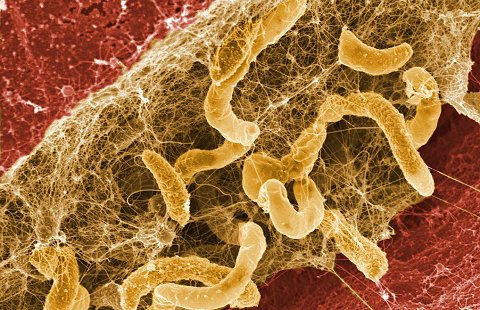Microbe Glue (EPS) in Biofilm Formation
- Sylvia Rose

- Feb 16
- 5 min read
Biofilms are prosperous microbial communities, complex networks of microorganisms including bacteria, fungi and algae. Their secretions, extracellular polymeric substances, are the glue holding them all together.

EPSs are high molecular weight natural polymers secreted by microorganisms. Made of different secretions and materials, they influence the composition, structure, and functionality of biofilms.
These substances help create a structural basis for biofilms. A significant portion of the microbial world thrives in biofilms. Without EPS, a biofilm disintegrates, leaving its inhabitants vulnerable.

EPSs are made up of biomolecules such as polysaccharides, proteins, lipids, nucleic acids and minerals.
Polysaccharides
These complex carbohydrates are often the major structural component of EPS. They provide the skeleton of the structure, and contribute to the biofilm's overall manifestation.
Different species of bacteria, algae, and yeast produce distinct polysaccharides. Each biofilm has unique properties. Some bacteria produce cellulose, a robust polysaccharide for rigidity.

Alginate, secreted by the marine bacterium Pseudomonas aeruginosa, is known for its ability to enhance the viscosity of biofilms. This helps nutrient retention and microbial interaction in densely populated environments.
Proteins
Proteins contribute to the EPS matrix in both structural and enzymatic ways. They can hold EPS components together, or include enzymes to break down nutrients and degrade toxins in biofilm environments.

Some proteins facilitate cell adhesion to surfaces, an important step in biofilm formation, as well as the daily life of immotile cells. Proteins also work as signaling molecules.
In yeasts, glycoproteins in EPSs enable cell-to-cell communication, promoting biofilm development. In Saccharomyces cerevisiae 70% of genes in this communication are regulated by glycoproteins.

Nucleic Acids
Both DNA and RNA are routinely found in EPS matrices. While their exact functions are still being investigated, they are believed to contribute to the biofilm's genetic diversity and stability.
DNA released from lysed or decomposing cells can be taken up by other members of the biofilm. This contributes to horizontal gene transfer and adaptation.

Lipids & Lipopolysaccharides (LPS)
Lipids provide a hydrophobic barrier within the EPS matrix, helping maintain the biofilm's hydration levels to prevent desiccation. LPS is primarily associated with gram-negative bacteria.
Gram negative bacteria include Escherichia coli and Proteus spp. LPS
can contribute to the biofilm's charge and interaction with the surrounding environment and adhesion to surfaces.

Minerals
Depending on the environment, EPS can also incorporate minerals like calcium, iron, or phosphate. These minerals can contribute to the biofilm's rigidity, serve as nutrients, or even provide protection against harsh conditions like UV radiation.
Additionally, nucleic acids, particularly extracellular DNA (eDNA), enhance the structural stability and provide nutrients for microorganisms during stress. For example, eDNA in bacterial biofilms contributes to up to 20% of the total biofilm mass, highlighting its significance in microbial ecology.
These diverse components enable EPSs to perform functions such as maintaining biofilm shape and protecting from antimicrobial forces.

EPS: Protection and Survival
The presence of this complex EPS matrix profoundly impacts the life of the microorganisms within the biofilm.
Structural Support
The EPS matrix provides a cohesive framework holding the microbial community together, allowing cells to remain in close proximity and cooperate in essential metabolic processes.
EPSs significantly enhance the stability of biofilms. Biofilms formed by Staphylococcus aureus have great strength due to a robust EPS matrix. The matrix acts as a barrier against antibiotics and host immune responses.

Similarly, biofilms created by Candida albicans, a common yeast, use EPSs for stability. The polysaccharide-rich matrix organizes yeast cells and protects against host immune defenses.
In aquatic ecosystems, algal biofilms use EPSs to retain moisture and create habitats for other microorganisms. The polysaccharide secretions stabilize the biofilm and provide a nutrient reservoir.
Protection
Survival is the name of the game. EPS is a physical barrier against environmental stresses. It shields microbes from desiccation, UV radiation, changes in pH and chemicals like disinfectants and antibiotics.

In aquatic environments the EPS matrix adapts to and protects against physical disruptions, such as water turbulence. Biofilms by Synechococcus, a genus of photosynthetic cyanobacteria, endure high flow rates.
EPSs shield microbial communities from predation by protozoa. For instance, Pseudomonas fluorescens biofilms develop a thick EPS layer to deter grazing by predatory protozoa.
In antibiotic resistance, the dense matrix limits antibiotic diffusion. This is a problem in healthcare settings, where most biofilm-related infections occur. Up to 65% of bacterial infections in hospitals are associated with biofilms.

Nutrient Capture
EPS is a nutrient trap, capturing and concentrating essential resources from the surrounding environment, ensuring a steady supply of food for the biofilm inhabitants.
Cell-to-Cell Communication
EPS facilitates communication between cells within the biofilm. Signaling molecules, such as quorum sensing molecules, can diffuse through the EPS matrix, coordinating gene expression and behaviors within the community.

Pseudomonas aeruginosa is a notorious bacterium which produces a robust EPS matrix in the lungs of cystic fibrosis patients, contributing to chronic infections that are very difficult to treat.
Streptococcus mutans, a primary cause of dental caries, forms biofilms on teeth. Its EPS enables it to withstand flushing actions of saliva and metabolize sugars to produce acids corrosive to tooth enamel.
Many algal species, especially marine diatoms, form extensive biofilms on ship hulls and other submerged surfaces. The EPS produced by these microalgae causes significant economic losses in the shipping industry.

Non-Fiction Books:
Fiction Books:
READ: Lora Ley Adventures - Germanic Mythology Fiction Series
READ: Reiker For Hire - Victorian Detective Murder Mysteries


